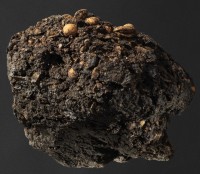 A piece of poo recovered from a latrine in Aalborg, Denmark, has been identified as the likely product of the colon of 17th century bishop Jens Bircherod. It was excavated from the latrine of the Aalborg bishop’s palace when the structure was demolished in 1937 for construction of Budolfi Square in the city center. The stool was of no interest to archaeologists at the time — poop studies have only recently come to be appreciated as the motherlode of information they are — but it was embedded in a broken bottle. The bottle and some Delft porcelain were put in a cardboard box and stored at the Moesgaard Museum. Researchers came across the historic turd while doing research on the thriving immigrant communities of Early Modern (1450-1650) Aalborg, Aarhus, Elsinore and Nya Lödöse.
A piece of poo recovered from a latrine in Aalborg, Denmark, has been identified as the likely product of the colon of 17th century bishop Jens Bircherod. It was excavated from the latrine of the Aalborg bishop’s palace when the structure was demolished in 1937 for construction of Budolfi Square in the city center. The stool was of no interest to archaeologists at the time — poop studies have only recently come to be appreciated as the motherlode of information they are — but it was embedded in a broken bottle. The bottle and some Delft porcelain were put in a cardboard box and stored at the Moesgaard Museum. Researchers came across the historic turd while doing research on the thriving immigrant communities of Early Modern (1450-1650) Aalborg, Aarhus, Elsinore and Nya Lödöse.
Cherry pits and one hazelnut were visible with the naked eye, but detailed archaeobotanical analysis of the crap discovered the pooper’s diet was varied and high quality. It was replete with seeds, nuts, cloudberries, blackberries, peppercorns and exotic fruits like figs and grapes. The cloudberry, imported from Norway, is the earliest found in Denmark. The pepper was imported from India and was a luxury good.
The smoking gun was the presence of buckwheat. In late 17th century Denmark, buckwheat was almost exclusively grown on the island of Funen. Bishop Jens Bircherod was born in Odense, Funen’s main city and the site of another most excellent poop discovery, in 1658.
“It all fits nicely with the bishop who lived in that house from 1694 to 1708,” says Jette Linaa, from Moesgaard Museum in the Danish city of Aarhus.
The general diet for the people of Aalborg at that time was gruel, cabbage, pork and beef but buckwheat was particular to the island of Funen, some 200km (125 miles) away.
“He had a typical upper-class diet, he was part of the upper class,” she told the BBC.
Bircherod also refers in his diaries to his “opulent dinners.” As part of the team’s research into the immigrant community of Aalborg, they found a German-owned pharmacy which had the city’s largest stock of pepper and figs and held the monopoly on the sale of herbs and spices. Only the wealthiest people in Aalborg could afford to purchase its wares, the city’s nobles, political office holders and its bishop among them. Other people lived in the bishop’s mansion, of course, including his wife and children, so it’s possible the poop was contributed by someone else in the household, but the buckwheat signature points to the man himself, and the fanciness of the diet likely excludes the servants.
The research team is elated by the feces they’ve found. This one bishop’s turd lends new insight into the international lifestyle of the prosperous residents of the city in the late 1600s. Before, they only had documentary sources to go on. The poop is concrete archaeological evidence of how the products of international trade wound up on the tables of Aalborg’s elites. They plan to study the contents of two other Aalborg latrines to flesh out the picture even further.